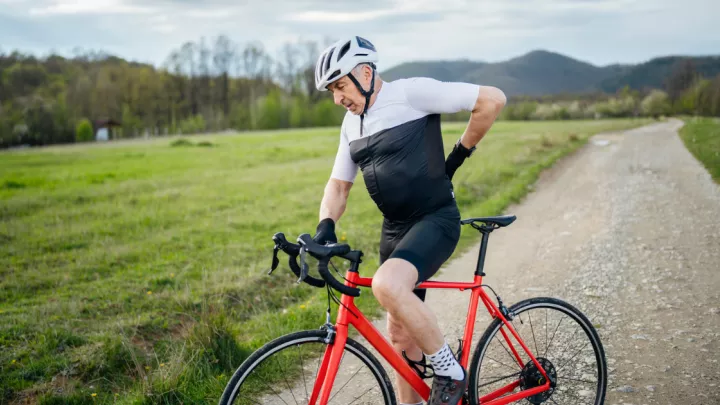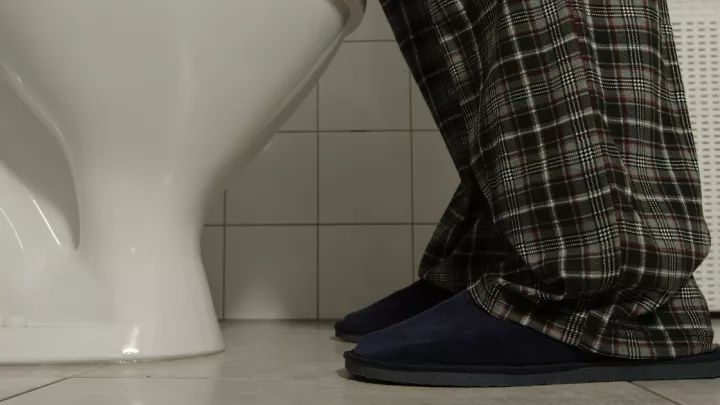Tight hip flexors may be causing your knee pain

If you’ve been experiencing knee pain, trouble running, bending or climbing, the source of the pain may be the knee joint itself. For example, as we age, the wear and tear can lead to osteoarthritis, a common source of knee pain. But did you know that issues in other parts of the body ─ like your hips ─ can also lead to knee pain.
For example, when hip flexors are tight, they can pull your pelvis into a forward tilt, which places extra strain on the knees. This can lead to pain and dysfunction in the knee joint. Problems in the hips can lead to a variety of knee issues, including:
Increased knee stress: A forward pelvic tilt shifts pressure onto the patellofemoral joint (the kneecap and thighbone) and other structures around the knee.
Iliotibial Band Syndrome: Tight hip flexors can contribute to iliotibial band syndrome, which causes pain on the outer knee.
Patellofemoral Stress Syndrome: Tight hips can cause misalignment of the kneecap in the groove of the femur.
Muscle Imbalances: Tight hip flexors can cause imbalances with other hip and knee muscles, leading to pain and dysfunction.
How do I know if tight hip flexors are causing my knee pain?
If knee pain is affecting your daily activities ─ like walking, bending or climbing ─ it’s a good idea to see an orthopaedic specialist. They can give you a full evaluation and determine what is causing the pain. Depending on the cause, they might refer you to a physical therapist for treatment.
“If a patient has tight hip flexors causing an issue with their knee, one of the first things I’ll evaluate is general hip mobility,” says physical therapist Brian O’Reilly, PT, DPT. “If mobility looks good, I’ll look for an area of weakness. For example, if you have overly tight hip flexors, glute weakness often creates instability at the hips.”
Some patients have good mobility and strength while still experiencing pain. In those cases, a physical therapist can break down movement mechanics. For runners that involves running patterns, cadence and running form. For weightlifters, they’ll evaluate lifting form. And for people who are having pain with walking and normal daily activities, a therapist will look at walking and movement patterns.
“Sometimes a person can have morphologies of the bone in the hip area which can limit mobility and trick people into thinking it's the hip flexor,” says O’Reilly. “So, it’s important to see an orthopaedic specialist to identify the root cause of knee pain.”
Often, it’s a combination of issues involving the hip and knee area. With tight hip flexors, hamstrings are often causing an issue. If a person tries exercises or stretches to work on a hip flexor, without identifying the root cause of the pain, those exercises can make things worse.
What can I do to relieve tight hip flexors?
Every individual is different, so it’s important to follow the advice of an orthopaedic specialist or physical therapist. They will look at the entire problem and prescribe the best course of treatment.
“It’s important to note that hip flexor exercises, such as those you might see on social media, are not one-size-fits all,” says O’Reilly. “For example, if I give two people the same hip flexor stretch, person A may feel great relief, while person B might feel burning or pain.”
Some issues are more chronic in nature. For instance, runners will rarely stop running. But there are a variety of approaches that a physical therapist can perform to release tight hip flexors. This includes manual releases or techniques like dry needling.
If a person sits most of the day, their muscles will adapt and shorten. This makes it more uncomfortable when they try to stretch them. In that case, standing desks, frequent movement breaks and quick desk stretches can help. But again, the most helpful approach would be to avoid sitting for long periods of time.
Exercises and stretches to relieve tight hip flexors
The following are a few simple exercises that can help to relieve tight hip flexors. If you have experienced pain or limited mobility, seek the advice of an orthopaedic doctor to diagnose the source of the issue. If you feel pain or a burning sensation while doing any exercise, stop and seek professional advice before continuing.
Modified Thomas Stretch
Hold the stretch for 30-60 seconds, repeating 2-3 times. You can do this stretch 1-3 times a day.
Setup: Begin lying on your back at the edge of a table or bed with your knees bent and feet resting flat on the bed.
Movement: Lower your outside leg off the table until you feel a stretch in the front of your hip and hold.
Tip: Try to keep your back flat on the bed during this stretch.
Half Kneel Dynamic Hamstrings and Contralateral Hip Flexor Stretch
Setup: Begin in a half kneeling position with one leg straight out in front of your body.
Movement: Arch your back and lean back until you feel a stretch in the back side of the straight leg. Tighten your core muscles, tilt your pelvis backward, and gently push your hips forward. You should feel a stretch in the front of your hip. Alternate between these positions. Repeat 8 to 10 times on each side.
Tip: Make sure you pay attention to the position of your pelvis – a forward tilt is used to stretch your back thigh muscle, and a backward tilt is used to stretch your front hip muscle.
Supine Hip Adductor Stretch
Hold the stretch for 20 to 30 seconds. Repeat 2 to 4 times on each side.
Setup: Begin lying on your back with your knees bent and feet flat on the floor.
Movement: Let one knee fall out to the side until you feel a stretch on the inside of your leg. Hold this position.
Tip: Make sure to keep your low back flat against the ground and don’t let your trunk rotate during the exercise.
Standing Hip abduction with Anchored Resistance
Complete 2 – 3 sets of this exercise. Repeat 10-15 times on each side.
Setup: Begin in a standing upright position balancing on one leg with a resistance band anchored in a door jamb to your side and secured around your ankle that is furthest from the anchor point.
Movement: Slowly draw your leg out to the side, away from your body, creating further tension in the band. Then carefully bring your leg back to the starting position.
Tip: Keep the knee of your moving leg straight and don’t allow your trunk to wobble. Make sure to keep your shoulders and hips level and facing straight forward during the exercise.
Call 800.922.0000 or schedule online for an appointment with an orthopaedic specialist.







